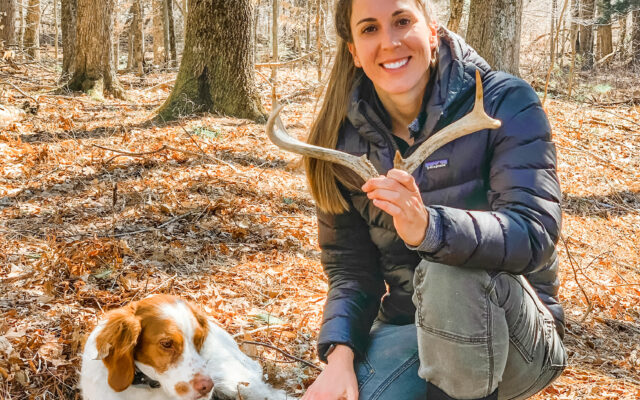
This is a great time to go searching for Maine deer antlers
By Christi Holmes
Every winter the antlers from Maine’s male deer and moose drop off and the animal grows a new set. Antlers can grow up to an inch per day and are one of the fastest-growing animal tissues in the world.
Looking for shed antlers is a great winter activity. It keeps you active during Maine’s long, cold, dark winter. If you’re successful, you’ll have a neat memento, and if you’re unsuccessful, well, you still got outside and went for a walk. You can also learn and study the tracks of other wildlife while you’re searching. If you’re a deer hunter, you’ll gain useful insight into your hunting area while looking for sheds.
There are many uses for a shed antler. You can simply place it on your mantle, or get crafty by making a coat, hat or jewelry rack. You can give it to your dog to chew on; antlers are a natural long-lasting chew that is a good source of minerals and help with tartar control.
There also is a commercial antler market. Serious shed “hunters” scour northern Maine in search of freshly dropped moose antlers, which are then cut up and sold as dog chews. A piece the size of a candy bar sells for about $25-$35.

ANTLERS FIND — Bangor Daily News Outdoors contributor Christi Holmes came upon this matched set of shed antlers a few years ago while searching with her dog, Argos.
I don’t take shed hunting too seriously, myself. When I have a free afternoon, I’ll go to a piece of woods and follow deer tracks in the snow. Some people grid search by searching in organized spaces but I’m not that disciplined. I follow tracks and scan the area.
When I find impressions in the snow indicating deer have bedded down, or when I notice meandering tracks with pawings or freshly chewed vegetation, indicating a feeding deer, I slow down and look a bit more closely. If the tracks lead under a low branch or over a fence or stream, I search harder in the area, as the antler may have been knocked free.
You can find antlers year round, but a fresh, brown antler is easiest to spot on white snow. Timing is very important. Go searching too early in the year and the deer haven’t dropped their sheds. Go too late and the antlers are buried in snow or rodents have chewed on them. I start looking in early February and only after we’ve had a stretch of clear weather.
If you are lucky enough to find a shed, don’t be disappointed if it’s small. The smaller the shed, the harder it is to find. Every antler is a trophy. You may come across a dead deer that died due to predation or a car collision. This is a great trophy, too, but you’ll need to contact the Maine Department of Inland Fisheries and Wildlife to obtain a tag to keep the skull.
One year, I got a text from a landowner that he had seen a nice buck with only one antler. That weekend I walked the woods nearby with my dog, Argos. I am always amazed at how quiet the woods are in winter. I walked about 4 miles, following tracks with no luck.
I knew it was like searching for a needle in a haystack, but I was still defeated as I walked back to my truck. Then, only 100 yards from my truck, I spotted the antler with a thick brow tine. The subsequent weekends I searched for the buck’s other antler but never found it.
Though Argos loved to walk the woods, he didn’t actually help me find any deer sheds. However, you can train dogs to find them. They instinctively are interested in bones, and antlers are made of bone. Whether or not your pup helps you find antlers or just keeps you company, it’s a great activity to do with your dog.